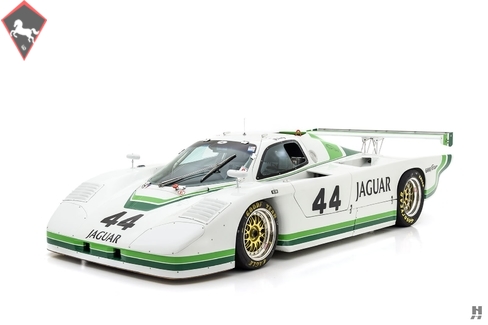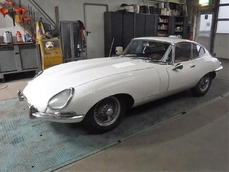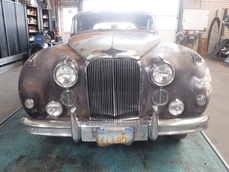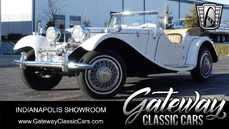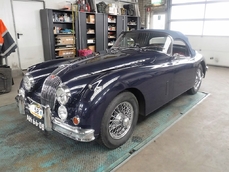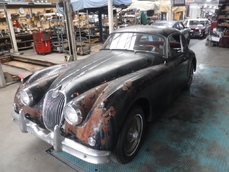Jaguar Other 1984
Allgemeine Beschreibung :
In the early 1980s, British Leyland was collapsing under its own weight and the entire fate of that nation’s motor industry was in peril. With the fate of storied marques like Triumph, MG, and even Jaguar in question, motor racing was low on the priority list and the funds were cut off to virtually every works or semi-works program. The ripple effect was felt across the pond in the USA as well, where longtime BL racing stalwart Bob Tullius was suddenly left without a car to run, despite his years of success with Jaguar and Triumph.
Tullius had started racing in the early 1960s, securing a D-Production national championship in 1964 at the wheel of a Triumph TR4. He worked through the ranks of American sports car racing, scoring numerous wins along the way. But Tullius was more than just a hot-shoe driver – he was a shrewd businessman who, through the creation of Group 44 Racing Inc, essentially created the modern concept of the professional racing team. Group 44 would become one of the first teams (alongside Penske Racing) to adopt a business-like approach to building and running race cars. While other teams chased the hottest car year to year, Tullius remained staunchly loyal to Triumph, MG, and Jaguar; his cars always impeccably turned out in their signature white and green livery. He maintained long-term partnerships with sponsors Quaker State Oils and Goodyear, providing them unprecedented value through promotions, press, and plenty of on-track success. Supported by British Leyland, Tullius and Group 44 developed the somewhat unwieldy V12-powered Jaguar E-type into a formidable challenger for the B-production championship. Jaguar’s stock rose further when the even less-likely XJS walked away with the 1977 and 1978 Trans Am titles. By the end of the 1970s, Tullius and his signature Group 44 cars were synonymous with Jaguar, and company bosses recognized the tremendous value of that relationship.
After the fall of Leyland, the fate of Group 44 was in jeopardy. But in late 1981, the head of Jaguar North America hinted to Bob that he shouldn’t sign with anyone until he heard from Jaguar UK. Tullius’ patience paid off when Group 44 was tapped to run a works-supported team in the hotly contested IMSA Camel GTP series, which Jaguar saw as a stepping stone to a Le Mans return. Bob jumped at the opportunity and expanded his team to build a new GTP car from the ground up and secured the talents of Lee Dykstra to design a new chassis, and Randy Wittine to pen the bodywork. Jaguar’s insistence of having Briton Patrick Head design the car was met with fierce resistance as Tullius knew he needed designers that understood the intricacies of building a car for the uniquely American GTP series. He got his way and by August of 1982, the first Group 44 Jaguar XJR-5 rolled out of the workshop.
The XJR-5 was a stunningly beautiful race car, turned out with the typical exquisite preparation that Group 44 was known for. That the XJR-5 was initially outclassed by the dominant Porsche 962 almost didn’t matter – its beauty, heritage, and ear-splitting V12 soundtrack made it an instant hit with the rabid IMSA fans. Despite being down on power compared to the turbocharged Porsche, the XJR-5 could still win races – winning several events between 1982-1986 and scoring numerous other podium finishes along the way. The Group 44 XJR-5 and XJR-7 GTP programs paved the way for Jaguar’s later Group C efforts and victory at LeMans.
Our featured XJR-5 is chassis number 010, the very last car built and raced in-period by Group 44. Approximately 13 cars in total are known, though three have been built up from spares. Chassis 010 raced in the 1984 and 1985 IMSA seasons and features numerous developments that set it apart from earlier cars. Most notable is the addition of fuel injection (early cars ran Weber carburetors) that allows the 6.0 liter Jaguar V12 to develop nearly 650 horsepower. Chassis number 010 was run in-period by a laundry list of legendary drivers – Doc Bundy, Chip Robinson, Brian Redman, Hurley Haywood and of course Bob Tullius – and it carries their signatures on the tub. According to information from Group 44, chassis 010 won the 1985 Road Atlanta 500KM with Redman and Haywood, in a one-off appearance wearing race number 04. As #44, it scored several more podiums and top-tens in its career, mainly with Tullius, Robinson, and Bundy at the helm. This car was also sent to Le Mans twice, though only to serve as a backup for chassis 06 & 08. It remained with Tullius until 2008 when it was sold to a noted racer and collector, Rick Knoop. More recently, it has participated in the Daytona Classic 24, the Palm Beach Historics and multiple Monterey Historics (with F1 veteran Stefan Johansson driving on one occasion).
Benefitting from a meticulous restoration in 2008 led by Rick Knoop and Jim Busby, XJR-5 010 presents in stunning concours-quality condition yet it remains fully sorted and ready to race. The original bodywork has been fully restored in its iconic Group 44 livery, with exquisite paintwork and detailing. The chassis and original alloy tub have been fully rebuilt, and it is plumbed and wired with the same meticulous care that Bob Tullius would have insisted upon in 1984. The thundering Jaguar V12 has been fully rebuilt by Ed Pink Racing Engines and has fewer than 25 hours since the rebuild. While capable of a screaming 8500 rpm, the current owner has wisely kept it below 6000 to ensure longevity. Mated to the engine is a freshly rebuilt Carl Haas Hewland dog-box, complete with cryo-treated gear sets and a new differential. It is reported to be very reliable and an absolute joy to drive – even at speeds approaching 200 mph on the banks at Daytona. As a testament to its quality and presentation, it has been shown at the Amelia Island Concours, and won its class at the Quail Motorsports Gathering and the Carmel Concours.
The sale of this legendary historic racer will include a comprehensive spares package consisting of spare bodywork (including a nose with headlights), suspension components, race and show wheels, spare block, new crank, and spare heads along with a complete road-going V12 with all of the necessary ancillaries needed for an additional complete spare engine build. The history and specification are fully documented with log books and spec sheets from the restoration, and numerous promotional materials and press kits are included as well.
Impeccably finished and prepared, this truly stellar, race-winning Jaguar XJR-5 is both a proven concours competitor and eligible for entry in a wide number of racing events around the world, including Historic Group C (Class 1 b), Le Mans Classic, and the HSR Classic 24 at Daytona, among many others. The GTP era was notoriously tough on cars, and it is rare to see examples from this historic period restored to such a high standard. This is an unmatched opportunity to acquire one of the best XJR-5s extant; a genuine semi-Works Jaguar racer with magnificent history at the hands of some the greatest sports car drivers of all time.
https://hymanltd.com/vehicles/6220
1984 Jaguar Other is listed verkauft on ClassicDigest in St. Louis by Mark Hyman for $1125000.
Fakten der Auto
Karosserietyp : Auto Marke : Jaguar Modell : Other Hubraum : 0.0 Modelljahr : 1984 Lage : Missouri
Verkauft
Angaben Zum Verkäufer
Verkauft
People who viewed this Jaguar Other also viewed similar Jaguar listed at ClassicDigest
Other cars listed for sale by this dealer
über Jaguar
Ah, die Geschichte von Jaguar, von seinen Anfängen als SS Cars Ltd. bis hin zum Höhepunkt mit dem D-Typ und der Straßenversion des ikonischen E-Typs. An dieser Erzählung haftet etwas zutiefst Britisches, und ich werde sie erzählen, wie es ein britischer Journalist tun würde.Die Anfänge:
Unsere Reise in die Welt von Jaguar beginnt in den 1930er Jahren, als ein Unternehmen namens SS Cars Ltd. auftauchte. Trotz des unglücklichen Zufalls ihrer Initialen, die mit den aufkommenden politischen Spannungen in Europa zusammenfielen, begannen sie, stilvolle und leistungsorientierte Autos herzustellen. Der SS 100, der 1936 eingeführt wurde, war ein Symbol für Eleganz und Geschwindigkeit und legte den Grundstein für das, was Jaguar werden sollte.
Die Geburt von Jaguar:
Als der Schatten des Zweiten Weltkriegs näher rückte, entschied sich SS Cars Ltd. klugerweise, sich von den SS-Initialen zu distanzieren. So wurden sie 1945 offiziell zu Jaguar Cars Ltd., ein Name, der bald für britischen Luxus und Leistung stehen würde.
Die XK-Serie:
Die Nachkriegszeit von Jaguar brachte uns den XK 120, eine wahre Sensation im Jahr 1948. Mit seinem schlanken Design und einem leistungsstarken 3,4-Liter-Sechszylindermotor wurde er zum schnellsten Serienauto der Welt. Der XK 120 war die Blaupause für das, was kommen würde - Jaguars, die Stil mit Geschwindigkeit auf einzigartig britische Weise verbanden.
Die Dominanz des D-Typs:
Dann kam der D-Typ, eine wahre Rennlegende. 1954 eingeführt, gewann er in den 1950er Jahren dreimal Le Mans und zeigte die technische Kompetenz von Jaguar. Mit seiner innovativen Monocoque-Konstruktion und der ikonischen Finne hinten war der D-Typ der Höhepunkt von Jaguars Motorsporterfolgen.
Das Auftauchen des E-Typs:
Aber der wahre Wendepunkt kam 1961 mit der Einführung des E-Typs, oft von Enzo Ferrari als "das schönste Auto, das je gebaut wurde" bezeichnet. Seine lange Motorhaube, die geschwungene Karosserie und ein 3,8-Liter-Motor, der atemberaubende Leistung lieferte, machten ihn sofort zu einem Klassiker. Der E-Typ war nicht nur ein Auto; er war ein Kunstwerk auf Rädern und konnte auf der Straße 150 Meilen pro Stunde erreichen.
Straßen- und Rennsporterfolge:
Die Schönheit des E-Typs wurde durch seine Leistung auf der Rennstrecke unterstrichen. Die leichten E-Typen waren bei verschiedenen Rennveranstaltungen besonders erfolgreich und festigten den Ruf von Jaguar als eine Kraft, mit der man im Motorsport rechnen musste.
Das Zeitalter der Raffinesse:
Je tiefer wir in die Geschichte von Jaguar eintauchen, desto mehr erkennen wir, dass die 1950er und 1960er Jahre ein Zeitalter der Raffinesse und Expansion waren. Neben dem großartigen D-Typ und dem ikonischen Aufstieg des E-Typs führte Jaguar Modelle ein, die seinen Ruf für Luxus und Leistung weiter festigten.
Der MK2:
Ende der 1950er Jahre stellte Jaguar den MK2 vor, eine Sportlimousine, die Eleganz mit Leistung vereinte. Diese elegante viertürige Limousine war sowohl bei Bankräubern als auch bei der Polizei aufgrund ihrer außergewöhnlichen Geschwindigkeit und Handhabung beliebt. Der MK2 war ein Symbol für Jaguars Fähigkeit, Raffinesse mit Leistung zu verbinden und hatte auch eine erfolgreiche Rennkarriere.
Der XJ6:
Springen wir ins Jahr 1968, als Jaguar ein Auto auf den Markt brachte, das Jahrzehnte lang Luxuslimousinen definieren würde - den XJ6. Es war ein Meisterwerk der Ingenieurkunst und des Designs, mit einem sanften Reihensechszylindermotor, unabhängiger Hinterachse und einem geräumigen, wunderschön ausgestatteten Innenraum. Der XJ6 war ein Symbol britischer Eleganz und bot eine so sanfte Fahrt, dass es schien, als würde er förmlich über die Straße gleiten. Er wurde zum Flaggschiffmodell für Jaguar und setzte den Maßstab für Luxuslimousinen und zeigte ein Maß an Raffinesse, das die Konkurrenz staunen ließ.
Die Verschmelzung von Klassik und Moderne:
Während der MK2 und der XJ6 die Evolution der Limousinen von Jaguar repräsentierten, bewahrten sie das Engagement der Marke für Leistung und Luxus. Diese Autos gehörten nicht nur auf die Rennstrecke; sie fühlten sich genauso wohl auf den Prachtstraßen wie auf einer entspannten Fahrt durch die englische Landschaft.
Die Herausforderungen des Wandels:
Dennoch sah sich Jaguar mit dem Eintritt der 1970er Jahre, wie viele britische Automobilhersteller, finanziellen Herausforderungen und Veränderungen in der Eigentümerschaft gegenüber. Die Ära von British Leyland brachte sowohl Chancen als auch Schwierigkeiten mit sich, während die Marke durch verschiedene Fusionen und Übergänge navigierte.
Das Erbe des MK2 und des XJ6, zusammen mit dem D-Typ und dem E-Typ, definiert Jaguar weiterhin als einen Hersteller, der zeitlose Eleganz mit einer Leistungsstärke vereint. Diese klassischen Modelle, ob sie über kurvige Straßen gefahren oder als Sammlerschätze geparkt werden, dienen als Zeugnis für die anhaltende Präsenz von Jaguar in der Welt der automobilen Exzellenz.
Die Jaguar-Geschichte, von ihren Anfängen als SS Cars Ltd. bis zur Schaffung von Automobilikonen wie dem E-Typ, dem MK2 und dem XJ6, ist eine Reise, die das Wesen des britischen Automobilbaus widerspiegelt - eine Mischung aus Luxus, Leistung und Stil, die nach wie vor Enthusiasten und Kenner gleichermaßen fasziniert.
